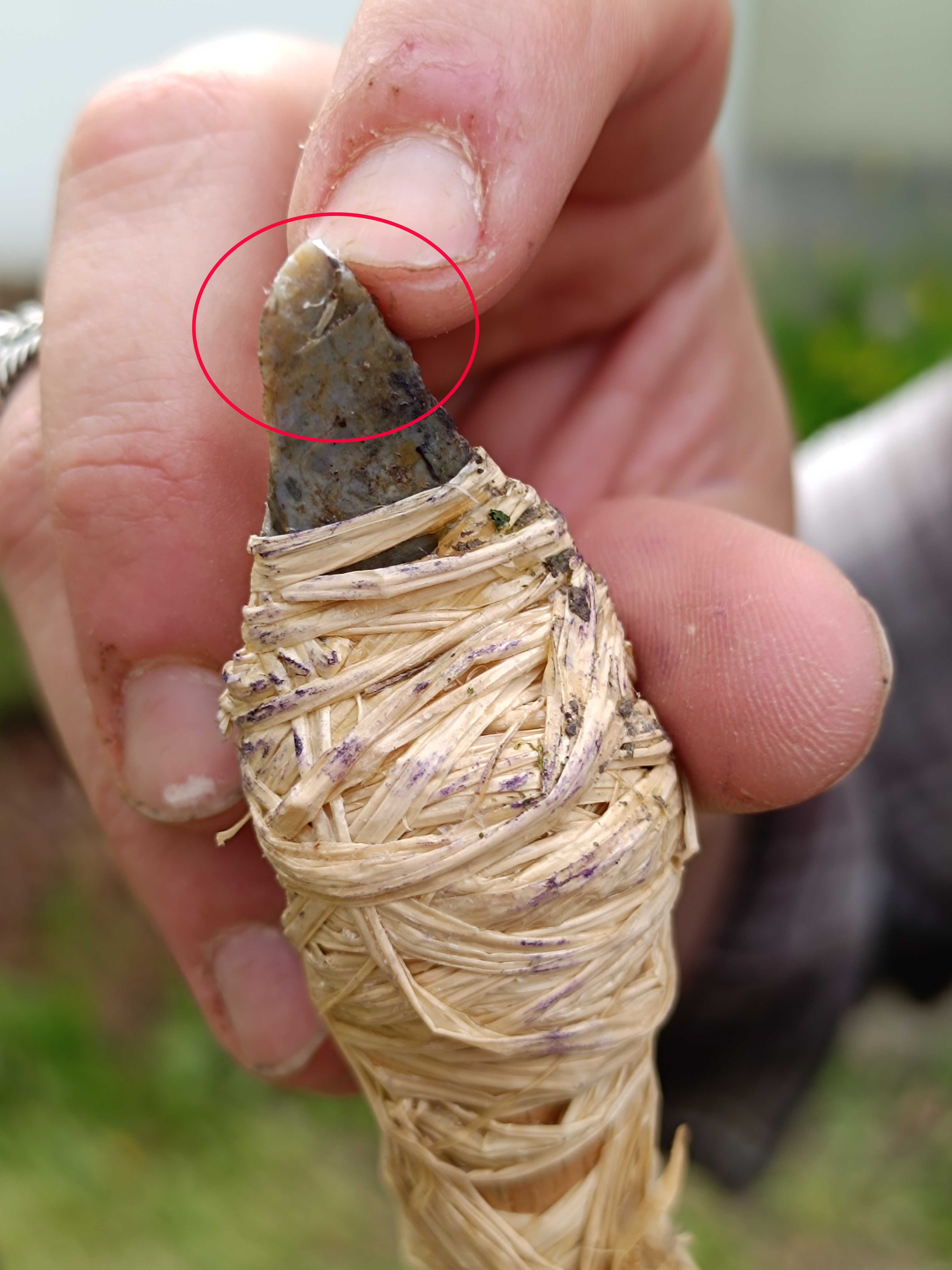Hafting tests on tanged blanks
Nassim Zejly, Bonnie Wright, Fanny Olivier, Narciso Domingos Sabao
Abstract
By the end of the Middle Pleistocene and the beginning of the Late Pleistocene (around 150,000 - 130,000 years ago), the Middle Stone Age in North Africa witnessed the emergence of tang technology. This innovation is characterized as a technical solution that facilitates hafting. Moreover, this technical behavior was consistently represented as point technology. This notion leads to the assumption that the tang was used for hafting in an axial orientation, with the tang being inserted into another material like wood or bone. However, what about the rest of the artifacts? What if the tang was not inserted but used for fixation instead?
In our experimental work, we explored alternative hafting methods where the tang was not inserted but used for fixation. These methods involved testing two hafting systems: the juxtaposition of the tanged artifacts onto wooden sticks, and the insertion of one edge adjacent to the tang. The choice of hafting systems was motivated by the thickness distribution of the produced convergent artifacts.
After hafting, we tested the functionality of these artifacts through three main activities: throwing the spear points, using the spears for penetration, and conducting butchering activities. The first two activities were tested on a simulation of animal carcasses using a mixture of gelatin and pig bones (two scapulae and two radius ulnae), while the butchering activities were conducted on fresh pig limbs.
Steps
1) Animal resin preparation : here is the followed recipe
Purify the water by boiling it, then let it cool down.
Put twice as much water than resin, then let it sit for 24 hours.
2) Gelatine tests : 4 different test were made to find out which is best for the fake carcass
3rd test :
400ml of water for 50g of gelatine : success.
4rth test :
450ml of distilled water for 50g of gelatine : success.
3) Gelatine preparation
We opted for 5L of water for 730g of gelatine.
4) Knapping
Creation of a database to register the information : https://docs.google.com/spreadsheets/d/1HfSV_gF87GJr9aV6UalQ8rctDjXmvuSQWcvl-Sfw4Mk/edit#gid=0
5) Hafting
Lateral hafting (8)
Material required :
-
tanged blank
-
standardised wooden stick
-
animal resin
-
vegetal fibre
Maintain the position and cover the whole with animal resin (on top and inside of the wood + around the tool). Covering it by spinning above the pot full of animal resin might be easier.
Axial Axhafting (6)
Material required :
-
tanged blank
-
standardised wooden stick
-
animal resin
-
vegetal fibre
Saw the wooden stick in order to split it widely enough to insert the tanged blank as desired.
Reduce the thickness of the stick on the end part and put the tang of the blank on top of the stick. If you use this method, your hafting device must be solid.
Maintain the position and cover the whole with animal resin (on top and inside of the wood + around the tool). Covering it by spinning above the pot full of animal resin might be easier.
Fix the point by using the vegetal fibre. Secure it by covering as much as you can, but let the active part of the spear show.
Additional step for the hafting of knives.
6) Spear use
Take a picture of everything (for the before / after use comparison).
Cutting : only one active part used on one raw material (pig limbs).
The cutting was done on pig’s trotters. There were two users, doing a skinning action.
We cut 7 times all around the leg and every 2 cm, then removed the strips of skin by cutting into the fat. We decided to carry out this action to observe at which level of the paw the marks on the bone are most visible.
Participant 1, who instead moved the knife back and forth, achieved a time of 28.15 minutes for the 7 rounds and 28.28 minutes for removing the strips of skin. Which makes a complete time of 56.43 minutes.
Participant 2, who cut with a rather sharp gesture, achieved a time of 19 minutes for the 7 rounds and 21.38 minutes to remove the strips of skin. Which makes a total time of 40.38 minutes.
Make an aditionnal database for used tools : https://docs.google.com/spreadsheets/d/1HfSV_gF87GJr9aV6UalQ8rctDjXmvuSQWcvl-Sfw4Mk/edit#gid=462676800 (sheet 2)
Piercing : static activity : no run-up. The target is at the experimentator's feet.
Don't hesitate to register individual information (height, weight, hands dimensions...)
Every use was filmed and a picture of the spear was captured after every use.
Every impact was located on the gelatine and marked, especially of a bone was touched.


Throwing : Settle with a fix distance for all of the users.
Don't hesitate to register individual information (height, weight, hands dimensions...)
Every use was filmed and a picture of the spear was captured after every use.
Every impact was located on the gelatine and marked, especially of a bone was touched.



7) Unhafting
Extract the potential splinters stuck in the gelatine.
8) Washing
9) Analysis
Bone analysis.
Lithics analysis.
Check the documentation for every use and register how many takes the participants succeeded in, for each use, each hafting system.

<img src="https://static.yanyin.tech/literature_test/protocol_io_true/protocols.io.x54v92jmml3e/qpgjcdua71.png" alt="Proportion of success for every tool orientation per participant ; "Hori" for axial fixation and "Verti" for the lateral insertion and fixation" loading="lazy" title="Proportion of success for every tool orientation per participant ; "Hori" for axial fixation and "Verti" for the lateral insertion and fixation"/>

Employ statistical tests by using the R package, to assess whether there were significant differences in success rates between orientations ("Hori" and "Verti"). Two common statistical tests, namely the two-sample t-test and the Wilcoxon rank-sum test, were used to compare success proportions for each participant individually and when their data were combined.







































